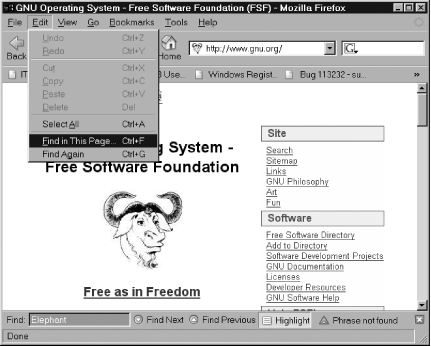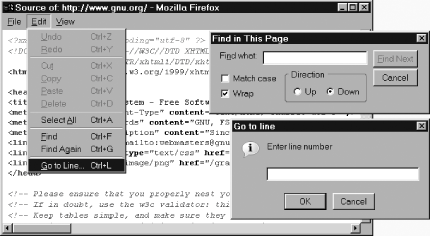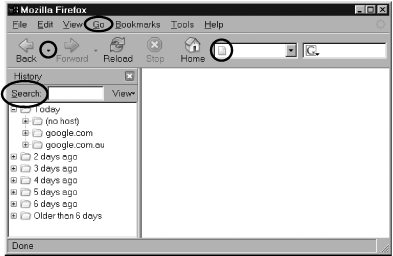Hack 3. Find Stuff
Search both the Web and the browser environment with Firefox. This hack explains how to find the stuff you've forgotten, left behind, or yet to discover. It starts with local information in the browser and works its way out to searching the furthest corners of the Web. 1.5.1. Search a Displayed Web PageYou can search the content of a displayed web page. To do so, Firefox provides the Find toolbar. It appears at the bottom of the browser window, above the status bar. Figure 1-5 shows most of the features. Figure 1-5. The Find toolbar and associated menu items This toolbar is
activated by the Edit
The Find toolbar contains two searches in one. The default search is the one just described, called Find As You Type. It can also be activated with the forward slash (/) key, or if there's nothing focused on the current page and you just start typing. The other kind of search is called Find Links As You Type. It can be activated with the single quote key ('). This alternate search scans only hyperlink text on the page. Use it to find specific links on big pages crowded with links. 1.5.2. Search Web Page SourceYou can also search the source code of a
web page, something that was never possible in old Netscape browsers.
View the page's source by choosing
View Figure 1-6. Find system for the View Source window This searching system doesn't use a Find toolbar, but it's similar. It supports full content searching only and doesn't support link searching. It does, however, support case-sensitive searches. 1.5.3. Search Your HistoryThere are several ways to search your surfing history. Figure 1-7 maps out these features. Figure 1-7. History searching features The most accurate search uses the Back and Forward buttons. Press the small, black down-arrow grippies that sit to the right of these icons. A drop-down list of the web trail for the current window appears. If you ever surfed up a blind alley, then reversed, and went forward in a different direction, the set of blind alley pages is lost from the web trail. Full URLs, form data, and scrolled position are all otherwise preserved. For another way to search, try the Go menu. It shows the most recently viewed URLs across all windows' session history. Only remote web pages are shown. Form posts and page scroll positions aren't preserved. As you view more pages, older items are pushed off this menu. To increase the size of the session history, modify this preference [Hack #23] : browser.session_history.max_entries /* 50 is default */ The History sidebar, displayed with
View browser.history_expire_days /* 9 is the default */ browser.history.grouping /* "none", "day" or "site" */ Finally, the Location bar can be used to search recently visited web sites in your global history. Type any string into the location bar and suggested domain name matches automatically appear in a drop-down list below the text box. This is called auto-complete. You can't search for path-specific bits of a URL until you've got the whole domain name (e.g., http://www.yahoo.com) right. 1.5.4. Search Your BookmarksAre you overflowing with
bookmarks
and can't remember any of them? Open the Bookmark
Manager using Bookmarks 1.5.5. Search for Lost LoginsTyped your username and password into a web site and then forgot what
they were? Firefox can help. Choose Tools Figure 1-8. Options preferences for form and password tracking Visit a web page with a form containing at least one text box, fill it in, and submit. Google's home page (http://www.google.com) is a good choice. Open a new Firefox window. Visit the page again. Left-click on the textbox twice. A drop-down menu appears, showing you the value you just typed. Pick the one you want. Alternatively, visit a web page requiring a login. I log in at http://bugzilla.mozilla.org a lot (follow the login link). Use Firefox's form completion to enter your username, and Password Manager automatically adds the password. Just click the Login button and you're in. Later on, you can review what you've saved. Back in
the Options dialog box, under Privacy 1.5.6. Search the WebThe Navigation toolbar includes a Search field on the extreme right. It uses the Google search engine by default. Type a keyword into the field and press Enter. Google replaces the current page with its search results. Alternatively, click on the small Google icon to see the other search engines installed by default; you can use any of them as well. Empty the Search field again and type a common letter, such as a. The Search box drops down a list of keywords starting with a that you've typed before. 1.5.7. Search for Firefox PreferencesFirefox has lots of preferences. Type in the URL about:config to see many (but not all) of them. There are too many to understand all at once. Type anything into the textbox labeled Filter: to restrict the list to the ones you care about (try typing go). The set of preferences is marginally different between Linux and Windows, but 99 percent of Firefox preferences apply to all platforms. |